User Profiles:
|
Incremental_RADIOSS
Incremental_LS-DYNA
RADIOSS One Step
Die Module
|
Use the Lines panel to create lines using a wide variety of methods.
Panel Usage
The Lines panel is organized into many subpanels. Each subpanel is accessed from a toolbar-like row of buttons along the top of the panel. In some cases, a single button can access more then one subpanel; this is indicated by the presence of a small downward arrow ( ) beside the button. Clicking this arrow reveals a drop-down list of possible functions for that button.
) beside the button. Clicking this arrow reveals a drop-down list of possible functions for that button.

On any given subpanel, most of the panel is devoted to inputs that determine the basis from which the line will be created--whether this is a series of nodes or points, existing lines, surfaces, or mesh features. In all cases the lines are generated by using the green command buttons on the leftmost edge of each subpanel; in most cases these buttons are create and reject, but in some cases they are drag or offset buttons. In all cases, reject undoes only the most recent line creation--it does not offer multiple levels of undo.
Numeric input data, toggles, and switch settings are generally preserved even if you change subpanels or leave the Lines panel altogether; when you return, the settings remain. However, entity selections such as node or line list collectors are cleared when you switch subpanels or return out of the panel.
Subpanels and Inputs
The following subpanels create nodes using specific methods. Each is accessed from a toolbar-like strip of buttons on the Lines panel, and some buttons--those with a small arrow to the right--have multiple values (click the arrow to change).
Note: This is not a true toolbar, as it cannot be undocked, moved, or hidden.
|
This subpanel creates lines by specifying (x,y,z) coordinates.

This line is created by typing in X,Y,Z coordinates of 3,3,3 for the start point and 8,8,8 for the end point.
There are several methods for entering the coordinate values:
| • | Type the coordinate values manually into the input boxes. |
| • | Populate individual coordinate values using the x, y and z collectors and selecting a node graphically. |
When using each of these collectors, the respective x, y, or z coordinate value is copied from the selected node into the corresponding input box. The values can be edited as desired.
| • | Populate the coordinate values using the as node collector and selecting a node graphically. |
This will copy the respective x, y and z coordinate values from the selected node into the corresponding input boxes. The values can be edited as desired.
|
This subpanel creates linear lines between nodes.
Two inputs are required to create a line using this method:
| • | The node list defines the nodes to use. A straight line segment is created between each node in the list. |

| • | The closed line option defines whether the first and last nodes in the list should be linked to form a closed line loop. |

|
This subpanel creates standard lines between nodes, with the possibility of reducing the number of joints and removing some nodes that fall outside of the line's path. The settings for determining joint creation and node removal are preset.
Two inputs are required to create a line using this method:
| • | The node list defining the nodes to use. |

Here, nine input nodes are simplified to six points, through which the line is fit.
| • | The closed line option defines whether the first and last nodes in the list should be linked to form a closed line loop. |

Here, thirteen input nodes are simplified to seven points, through which a closed line loop is fit.
A standard line is created by performing point reduction with the following parameters used:
| • | The break angle is set to 150.0 degrees. This specifies the minimum angle allowed between three points in a line. If the angle between a point and the two adjacent points is less than the angle specified, this point is considered to be a point of discontinuity in the line and a joint is placed at that location. |
| • | The aspect is set to 5.0. This specifies the maximum ratio allowed for the distance between a point and the previous point in the line, and the distance between the same point and the next point in the line. If the ratio of the distance between the two adjacent segments exceeds the aspect ratio defined, a joint is placed between the segments. |
| • | The linear angle is set to 179.0 degrees. This defines the angle at which a line is considered a straight line. If the line angle between three consecutive points along the line is greater than the angle specified, the center point is removed from the line. |
|
This subpanel creates smooth lines between nodes.

Here, thirteen input nodes are simplified to seven points, with smooth (curved) lines fit through them.
Four inputs are required to create a line using this method:
| • | The node list defining the nodes to use. |
| • | The closed line option defines whether the first and last nodes in the list should be linked to form a closed line loop. |
| • | The start slope option defines the line start point constraint. This option does not apply if the closed line option is enabled. |
If set to free, this end point is not constrained.
If set to normal, this end point is normal to the specified vector.
If set to vector with tangent to vector option selected, this end point is tangent to the specified vector.
If set to vector with length option selected, this end point parametric derivative equals the input vector, assuming a normalized spline parameterization from 0 to 1.
| • | The end slope option defines the line end point constraint. This option does not apply if the closed line option is enabled. |
If set to free, this end point is not constrained.
If set to normal, this end point is normal to the specified vector.
If set to vector with tangent to vector option selected, this end point is tangent to the specified vector.
If set to vector with length option selected, this end point parametric derivative equals the input vector, assuming a normalized spline parameterization from 0 to 1.
A smooth cubic line is created which fits through all of the specified nodes and has the specified start and end slope.
|
This feature is identical to standard nodes except that you can specify the values that determine joint creation or node reduction.
This subpanel creates controlled lines between nodes, with the possibility of reducing the number of joints and removing some nodes that fall outside of the line's path. The settings for determining joint creation and node removal are user-specified.
Five inputs are required to create a line using this method:
| • | The node list defining the nodes to use. |
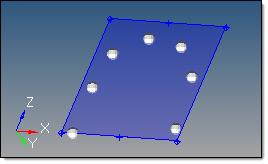
| • | The closed line option defines whether the first and last nodes in the list should be linked to form a closed line loop. |
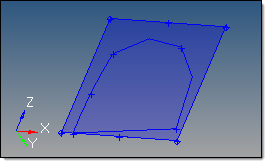
| • | The break angle specifies the minimum angle allowed between three points in a line. If the angle between a point and the two adjacent points is less than the angle specified, this point is considered to be a point of discontinuity in the line and a joint is placed at that location. |

This example uses a break angle of 150 degrees; the highlighted angle is closer to 100 degrees, so a joint is created.
| • | The aspect specifies the maximum ratio allowed for the distance between a point and the previous point in the line, and the distance between the same point and the next point in the line. If the ratio of the distance between the two adjacent segments exceeds the aspect ratio defined, a joint is placed between the segments. |

With an aspect of 5, the large gap (left) results in a joint (right) because it is more than 5 times the length of its neighbors.
| • | The linear angle defines the angle at which a line is considered a straight line. If the line angle between three consecutive points along the line is greater than the angle specified, the center point is removed from the line. |

The highlighted nodes are removed because they form lines with their neighbors that are greater than the linear angle setting.
A controlled line is created by performing point reduction with the specified parameters.
|
This subpanel creates lines by dragging nodes a specified distance along a vector.

This example shows the input node being dragged along the Y axis in the positive direction.
Four inputs are required to create a line using this method:
| • | A vector defining the direction to drag the node. |
| • | The distance defining the length of the line. This can either be provided directly, or when using the N1/N2/N3 vector definition, by using the distance between N2 and N1. |
| • | The direction of the drag. |
Drag + is defined using the specified vector direction.
Drag - is defined in the opposite direction.
A line is created at each node by dragging the nodes the specified distance along the given vector.
|
This subpanel creates arcs by specifying the center and radius. It can create multiple arcs in a single operation.
Five inputs are required to create a line using this method:
| • | A node list that defines each arc center. An arc is created around each node in the list. |
| • | A plane definition. Each node in the node list is used as a base node for the plane and the arc is created on that plane. |
| • | The radius of each arc. The radius is measured from each node in the node list. |
| • | The offset of each arc. This is an initial offset rotation for the start point of the arc. It is measured from the x-axis of the plane using the right-hand rule. |
| • | The angle of each arc. This is the total angle of the arc. It is measured starting from the offset angle using the right-hand rule. |

The node list (white) set the arc centers; the green (N1), blue (N2), and red (N3) nodes indicate both the direction of the arc and the plane.
This particular example uses a radius of 2, an offset of 15 degrees, and a total arc angle of 90 degrees.
|
This subpanel creates arcs by specifying two nodes and a vector. It can create multiple arcs in a single operation.
Four inputs are required to create a line using this method:
| • | A node list that defines a location on each arc. A separate arc is created through each node in the list. |
| • | A vector definition. This defines the plane whose normal runs through the center of the arcs and parallel to the plane in which they lie. The base node of the vector defines the arc center. |
| • | The offset of each arc. This is an initial offset rotation for the start point of the arc using the right-hand rule. |
| • | The angle of each arc. This is the total angle of the arc. It is measured starting from the offset angle using the right-hand rule. |

This example uses four nodes, an offset of 15 degrees, and an arc angle of 45 degrees (nodes and arcs are numbered for reference).
|
This subpanel creates arcs by specifying three nodes on the circumference.
Three nodes on the circumference are required to create an arc using this method. The first node defines the start point of the arc and the third node defines the end point of the arc. If more than three nodes are selected, only the first three are used.
Unlike the other arc creation methods, only one arc can be created at a time.

A single arc is created to fit through the nodes selected.
|
This subpanel creates circles by specifying the center and radius. Multiple circles can be created in a single operation.
Four inputs are required to create a line using this method:
| • | A node list that defines each circle center. An circle is created around each node in the list. |
| • | A plane definition. Each node in the node list is used as a base node for the plane and the circle is created on that plane. |
| • | The radius of each circle. The radius is measured from each node in the node list. |
| • | The offset of each circle. This is an initial offset rotation for the start point of the circle. It is measured from the x-axis of the plane using the right-hand rule. |

These three input nodes each receive a circle with a radius of 2 on the plane defined by the N1 green, N2 blue, and N3 red nodes.
|
This subpanel creates circles by specifying two nodes and a vector.
Three inputs are required to create a line using this method:
| • | A node list that defines a location on each circle. A circle is created through each node in the list. |
| • | A vector definition. This defines the plane whose normal runs through the center of the circles and parallel to the plane in which they lie. The base node of the vector defines the circle center. |
| • | The offset of each circle. This is an initial offset rotation for the start point of the circle using the right-hand rule. |

In this example the input nodes (white) each receive a circle that passes through them, bit is centered on the vector's base node (purple). The N1 green, N2 blue, and N3 red nodes define the plane on which the circles lie. The outermost circle results from node 3, the middle one from node 1, and the innermost one from node 2.
|
|
This subpanel creates circles by specifying three nodes on the circumference.
Three nodes on the circumference are required to create a circle using this method. If more than three nodes are selected, only the first three are used.
Unlike the other circle creation methods, only one circle can be created at a time.

|
This subpanel creates conic lines by specifying the start, end and tangent locations.
Four inputs are required to create a line using this method:
| • | The start point coordinates. |
| • | The end point coordinates. |
| • | The tangent point coordinates, which indicate the point of intersection between straight lines tangent to the created conic curve segment the at start and end points. |
| • | The ratio value. This is a parameter that defines the created conic curve segment “altitude”. Consider the segment that connects the tangents’ intersection point with the midpoint between the start and end points of the curve. If the length of this segment is used as the unit length, then the ratio is defined as the length of the portion of the segment that connects the midpoint with the point where the segment is intersected by created curve. Valid values are in the range 0 to 1. For a ratio of 0.5, the conic curve is a parabolic segment. For values between 0 and 0.5, the conic curve is an ellipse. For values between 0.5 and 1, the conic curve is a hyperbolic segment. |
A ratio of -1 can also be used to create a circular arc, provided the length of the tangent segments are equal.

In this example, the three pre-existing nodes used as input via the as node option for the criteria as labeled in the left image.
|
This subpanel creates lines as copies of surface edges.

Note the point markers (+) on the corners and edges in the second image; these lie at the ends and midpoints of the created lines.
Two inputs are required to create a line using this method:
| • | A line or surface to copy. If a line is selected, it must be a surface edge. If a surface is selected, all edges of that surface are considered. |
| • | The create in method, which defines the resulting lines component organization: |
Specifying the current component organizes the new lines to the current component.
Specifying the original component adds the new lines to the same component that the selected lines or surfaces belong to.
|
This subpanel creates lines at parametric locations on surfaces.
Eight inputs are required to create a line using this method:
| • | A surface that the parametric values are in reference to. |
| • | The create in method, which defines the resulting lines' component organization. |
Specifying the current component organizes the new lines to the current component.
Specifying the surf component adds the new lines to the same component that the selected surface belongs to.
| • | A lower u bound value, >= 0.0. |
| • | An upper u bound value, <= 1.0. |
| • | The number of u lines. This defines the number of lines created between the lower and upper u bounds. If specified as 0, no lines are created along the u direction. If specified as 1, a line is created at the lower u bound only. If specified as 2, lines are created at both the upper and lower u bounds. If specified > 2, lines are created at linear intervals between the lower and upper u bounds. |
| • | A lower v bound value, >= 0.0. |
| • | An upper v bound value, <= 1.0. |
| • | The number of v lines. This defines the number of lines created between the lower and upper v bounds. If specified as 0, no lines are created along the v direction. If specified as 1, a line is created at the lower v bound only. If specified as 2, lines are created at both the upper and lower v bounds. If specified > 2, lines are created at linear intervals between the lower and upper v bounds. |

This example uses u ranging from 0 to 0.75 with 5 u lines, and v ranging from 0 to 0.5 with 4 v lines.
|
This subpanel creates lines at the intersection of geometric entities: plane/lines, plane/surfaces, plane/elements, plane/plane and surfaces/surfaces.

This example uses plane/plane intersection; the planes are set to wireframe geometry and transparent mesh to show the resulting line.
Several inputs are required to create a line using this method:
| • | The type of geometry to intersect. Valid combinations include plane/lines, plane/surfaces, plane/elements, plane/plane and surfaces/surfaces. |
| • | For plane/lines intersections, the smooth lines option determines whether linear segments are created, or whether smooth curves are created. |
| • | For plane/elems intersections, the line segments option creates a separate line segment for each element. The combine lines option creates single line segments that are combined from the separate segments based on the following: |
The break angle determines where the intersection line will remain segmented. Segments with an angle relative to each other that exceed this angle will not be combined and will remain separate line segments.
The smooth lines option creates smooth curves within each line segment. The angles between different segments are still not smoothed, but angles less than the break angle are smoothed because segments within the break angle tolerance are combined into a single line segment.
|
This subpanel creates linear and smooth lines on surfaces using nodes.
Five inputs are required to create a line using this method:
| • | A surface that the lines will lie on. |
| • | A node list that defines the nodes on the surface through which the line will be created. The order of the nodes determines the path of the line. |
| • | The trim input surface option, which specifies if free lines are created or if the input surface is trimmed. |
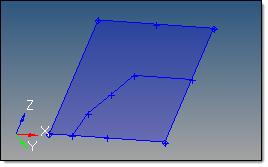
|
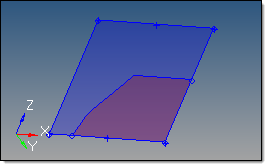
|
Here, free lines are coincident with the surface. The surface is not modified.
|
Here, the surface has been split into two different surfaces, one of which is recolored for this image.
|
| • | The create in method, which defines the resulting lines' component organization. This is only valid if the trim input surface option is unchecked. |
Specifying the current component organizes the new lines to the current component.
Specifying the surf component adds the new lines to the same component that the selected surface belongs to.
The linear option creates straight line segments between each input node.

The linear closed option creates straight line segments between each input node as well as between the first and last nodes in the list, thereby closing the loop.
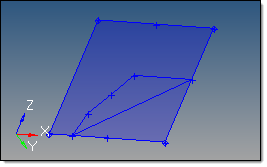
The smooth option creates a smooth line between the input nodes.
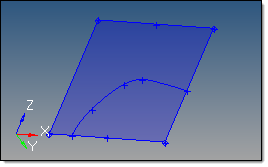
The smooth closed option creates a smooth line between the input nodes, including closing the loop using the first and last nodes.
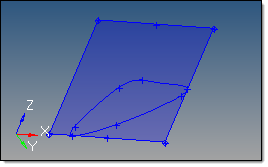
|
This subpanel creates lines by offsetting existing curved lines by a uniform or variable distance.
Six inputs are required to create a line using this method:
| • | The line list to offset. |
| • | The create in method, which defines the component that the resulting lines will be added to: |
Specifying current component organizes the new lines to the current component.
Specifying lines component adds the new lines to the same component that the selected lines already belong to. The result is unpredictable if lines from different components are used as input.
| • | The distance defines the length to offset the line along its normal. |
uniform: the line list is offset a uniform distance.
variable: the line list is offset linearly based on a start and end offset value.
| • | The start of the line list is indicated by the end of the chain that has the arrow after selecting the lines, but can be reversed using the switch start point option. |

| • | The link type defines how the offset is generated when there is a discontinuity (other than 180 degrees) in the direction of the curvature of the input line list--that is, when input lines do not connect with each other. There are 3 modes: |
interpolate: the offset direction is interpolated on both sides of the discontinuity to allow a smooth transition. In this case, along the interpolation region, the offset direction will be different than the curvature direction. Amplified fluctuations, which would occur in the offset because of small ripples in the input curve, are smoothed out with this option.
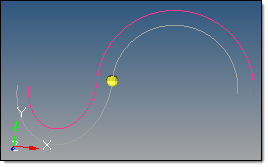
insert link: a straight line segment is inserted as a link between the offset of input lines, if there is a jump in offset direction at points where the input lines meet.
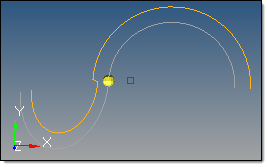
no link: no link is inserted if there is a jump in offset direction at points where input lines meet. In this case, the offset lines may become disconnected.
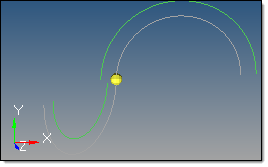
| • | The direction of the offset. |
An offset + is based on the curvature of the selected lines and is shown by an arrow at the start of the line list.
An offset - is defined in the opposite direction.
Closed lines are treated as if they were not closed so that the offset creates open lines.
Successive offsets (4-5 offsets, one after other) or very large offset values of some lines become sensitive to approximation errors or invisible fluctuations in the line.
|
This subpanel creates lines by interpolating between existing lines.

Two inputs are required to create a line using this method:
| • | A line list to use for the first side. |
| • | A line list to use for the second side. |
The result depends on the order of the input lines selection. If the shorter of the two line segments is input as the first list and the longer one as the second, the midline is generated with a length similar to the shorter line. In addition, the midline is created only between the first line segment and a portion of the second line segment.
If the longer line segment is input as the first selection, the length of the midline generated is an average of the two line lengths.
|
This subpanel creates and deletes fillet lines between free lines.
Four inputs are required to create a line using this method:
| • | The radius of the fillet. |
| • | The trim original lines option determines whether the original input lines are trimmed by the new fillet. |

When trim original lines is not active, the corner formed by the input lines remains.

When trim original lines is active, the input lines are trimmed to the start and end of the fillet.
When creating a fillet, the two closest end points are found and the tolerance between them is checked (geometry cleanup tolerance). If the two end points are within the tolerance, the radius must be greater than zero in order to create a fillet. If the two end points are not within the tolerance, and the radius is equal to zero, the closest end points of both lines are extended to their point of intersection, if such a point exists.
If the two selected lines contain at least one curved line, the fillet may not always be placed in the correct quadrant.
If the lines intersect, but not at their end points, the quadrant options are graphically displayed via a set of cross hairs. Pick the appropriate quadrant with the left mouse button.
If the two selected lines intersect in more than one place, the first intersection point is used.
For circular curves, if the arc is smaller than 180 degrees there are no issues. However, if the arc is closer to 360 degrees there may be problems. The algorithm only considers the start and end points of the circular curve to determine where to place the fillet with respect to the selected quadrant. To solve this problem, the curve should be split into segments that are longer than the second line but smaller than 180 degrees in angle of rotation.
One other option on the subpanel is delete line with fillet. This is not directly related to the creation of fillets described above, because the generated fillets are separate line segments. However, single lines that include fillets--such as line and fillet segments that have been combined on the line edit panel--can have their fillet removed by highlighting this option and then selecting the line that contains a fillet.

|
This subpanel creates tangent lines between a line and a node list or line.

This example shows a tangent created between two lines.
Three inputs are required to create a line using this method:
| • | The node list that defines the tangent origin, or the line that defines the first arc. If multiple nodes are specified for the node list, only the first node is used. |

This example shows tangents created between a node and a line.
| • | The line that defines the second arc. |
| • | The number of check points to use within each line segment for finding tangents. If the desired tangent is not found, increase the value. |

The selected nodes/lines must lie on a plane.
If more than one tangent is found, all the tangent lines found are displayed, and the desired tangent line can be graphically selected.
|
This subpanel creates lines perpendicular to existing lines, surfaces and solids from node or point locations.
Four inputs are required to create a line using this method:
| • | The lines, surfaces, or solids to create the lines perpendicular to. |
| • | The nodes or points that define the starting point locations for the perpendicular lines. |
| • | The create normal lines only option, if enabled, will only create perpendicular lines between the node/point and the closest input geometry. If disabled, the lines are created between the node/point and the closest input geometry but are not guaranteed to be perpendicular. When enabled, no line is created if it would not be perpendicular to the nearest point on the input line. |

This sequence shows the difference due to the normal lines only option from the same starting point; left is the input,
middle is the result with the option off, and right is with the option on (note that the uppermost node does not create a line
because the nearest possible connection point would not be normal to the curved input line).
| • | The create in method, which defines the resulting lines component organization: |
Specifying current component organizes the new lines to the current component.
Specifying input component adds the new lines to the same component that the selected lines/surfs/solids already belong to. The result is unpredictable if geometry from different components is used as input.
A line segment is created for each point/geometry combination.
|
This subpanel creates lines perpendicular from node or point locations on lines, surfaces and solids.
Five inputs are required to create a line using this method:
| • | The lines, surfaces, or solids to create the lines perpendicular from. |
| • | The nodes or points that define the starting point locations for the perpendicular lines. These must be attached/associated to the input geometry. |
| • | The create in method, which defines the resulting lines component organization: |
Specifying current component organizes the new lines to the current component.
Specifying input component adds the new lines to the same component that the selected lines/surfs/solids already belong to. The result is unpredictable if geometry from multiple components is used as input.
| • | The length of the line to create at each location. |
| • | The direction of the normal line: |
Normal + is defined as the positive normal direction at each node/point location on the geometry.
Normal - is defined in the opposite direction.
A line segment is created for each point/geometry combination.

The left image is the input; middle shows lines from geometry in the positive direction, while right is in the negative direction.
|
This subpanel creates lines that lie on a plane, are perpendicular to a line, and are defined from node or point locations.
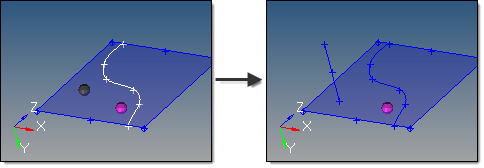
The line is created at the input point, normal to the nearest spot on the line, and (in this case) along the plane
for which the Z-axis is the normal (in other words, the X/Y plane).
Six inputs are required to create a line using this method:
| • | The node or point that defines the starting point location for the perpendicular line. |
| • | The line to create the line perpendicular to. |
| • | The create in method, which defines the resulting line's component organization: |
Specifying current component organizes the new line to the current component.
Specifying input component adds the new line to the same component that the selected line already belongs to.
| • | A plane definition. The new line will lie on this plane. |
| • | The length of the line to create. |
| • | The direction of the normal line: |
Normal + is defined as the positive normal direction at the closest location of the input geometry.
Normal - is defined in the opposite direction.
The new line has the specified length, is within the specified plane, is perpendicular to the specified line, and starts near the specified node/point.
|
This subpanel creates lines from element features.

In the second image, the elements are set to transparent so that the newly created lines are clearly apparent.
Five inputs are required to create a line using this method:
| • | The elems or comps to use as input. If comps are selected, the elements in the comp are used. |
| • | If ignore normals is selected, the direction of the shell face normals are ignored and a feature line is created between any two shell faces whose normals are more than the specified feature angle or less than its inverse (the feature angle minus 180 degrees). When this option is not selected, a feature line is only created between any two faces whose normals are more than the feature angle--in other words, the inverse angle is not considered. |
| • | The feature angle defines the maximum angle to allow between the normals of two connected shell elements. When the angle exceeds this value, a feature line is generated. |
| • | The break angle defines the minimum angle allowed between three points in a line. Line joints will be created whenever the line exceeds this angle. |
| • | The smooth lines option defines whether the lines are to be smoothed or not. |
|
Panel Inputs
The following inputs appear on the XYZ, Linear Nodes, Standard Nodes, Smooth Nodes, Controlled Nodes, Drag Along Vector, Arc Center and Radius, Arc three Nodes, Circle Center and Radius, Circle Nodes and Vector, Circle Three Nodes, and Conic subpanels.
Panel Inputs
Option
|
Description
|
X, Y, Z
|
Specify the components of a point. You can either type in values, or (with an X/Y/Z button highlighted) pick a node in the graphics area to populate each value individually.
|
As Node
|
With this box highlighted, pick a node in the graphics area to set the X, Y, and Z values equal to those of the selected node.
|
Node List
|
Use this collector to specify the node path along which you wish to create a line. A straight line segment is created between each node in the list.
|
Closed Line
|
Defines whether the first and last nodes in the list should be linked to form a closed line loop.
|
Start Slope: (free, normal, vector)
|
The start slope option defines the line start point constraint. This option does not apply if the closed line option is enabled.
| • | If set to free, this end point is not constrained. |
| • | If set to normal, this end point is normal to the specified vector. |
| • | If set to vector with tangent to vector option selected, this end point is tangent to the specified vector. |
| • | If set to vector with length option selected, this end point parametric derivative equals the input vector, assuming a normalized spline parameterization from 0 to 1. |
|
End Slope: (free, normal, vector)
|
The end slope option defines the line end point constraint. This option does not apply if the closed line option is enabled.
| • | If set to free, this end point is not constrained. |
| • | If set to normal, this end point is normal to the specified vector. |
| • | If set to vector with tangent to vector option selected, this end point is tangent to the specified vector. |
| • | If set to vector with length option selected, this end point parametric derivative equals the input vector, assuming a normalized spline parameterization from 0 to 1. |
|
Break Angle:
|
Specifies the minimum angle allowed between three points in a line. If the angle between a point and the two adjacent points is less than the angle specified, this point is considered to be a point of discontinuity in the line and a joint is placed at that location.
|
Aspect:
|
Specifies the maximum ratio allowed for the distance between a point and the previous point in the line, and the distance between the same point and the next point in the line. If the ratio of the distance between the two adjacent segments exceeds the aspect ratio defined, a joint is placed between the segments.
|
Linear Angle:
|
Defines the angle at which a line is considered a straight line. If the line angle between three consecutive points along the line is greater than the angle specified, the center point is removed from the line.
|
Nodes
|
Use this collector on the Drag Along Vector subpanel to pick the nodes you wish to drag.
|
(Plane and Vector Selector)
|
Whenever a standard plane and vector selector appears, use it to:
| • | Define a drag direction for selected entities, or |
| • | Define a plane whose normal runs through the center of an arc or circle and parallel to the plane in which they lie. The base node of the vector defines the arc or circle center. |
|
Distance:
|
Use this toggle to either specify a drag distance, or change it to N2-N1 to set the drag distance equal to the distance between the specified vector nodes.
|
Radius
|
The radius of each arc or circle, as measured from each node in the node list.
|
Offset
|
This is an initial offset rotation for the start point of an arc or circle. It is measured from the x-axis of the plane using the right-hand rule.
|
Angle
|
This is the total angle of an arc. It is measured starting from the Offset angle using the right-hand rule.
|
Ratio: (switch)
|
This parameter defines the created conic curve segment's “altitude”. Consider the segment that connects the tangents’ intersection point with the midpoint between the start and end points of the curve. If the length of this segment is used as the unit length, then the ratio is defined as the length of the portion of the segment that connects the midpoint with the point where the segment is intersected by created curve. Valid values are in the range 0 to 1. For a ratio of 0.5, the conic curve is a parabolic segment. For values between 0 and 0.5, the conic curve is an ellipse. For values between 0.5 and 1, the conic curve is a hyperbolic segment.
A ratio of -1 can also be used to create a circular arc, provided the length of the tangent segments are equal.
|
|
The following inputs appear on the Offset, Midline, or Fillet subpanels.
Panel Inputs
Option
|
Description
|
Line List
|
Use this collector to specify the existing lines that you wish to create new lines from, whether by offsetting from them (one Line List Collector) or creating midlines between the contents of two different Line List collectors.
For midlines, the result depends on the order of the input lines selection. If the shorter of the two line segments is input as the first Line List and the longer one as the second, the midline is generated with a length similar to the shorter line list. In addition, the midline is created only between the first line segment and a portion of the second line segment.
If the longer line segment is input as the first selection, the length of the midline generated is an average of the two line lengths.
|
Delete Original Lines
|
When active, this option deletes the lines selected in Line List.
|
Create In:
|
This toggle determines whether newly created lines are stored in the Lines Component or the Current Component.
|
Distance:
|
Either type in a value for a Uniform offset distance from the input lines, or type in separate values for the offset's Start and End distances. The offset distance is scaled linearly between these values.
|
Link Type:
|
Choose between Interpolate, Insert Link, or No Link.
| • | interpolate: the offset direction is interpolated on both sides of the discontinuity to allow a smooth transition. In this case, along the interpolation region, the offset direction will be different than the curvature direction. Amplified fluctuations, which would occur in the offset because of small ripples in the input curve, are smoothed out with this option. |

| • | insert link: a straight line segment is inserted as a link between the offset of input lines, if there is a jump in offset direction at points where the input lines meet. |

| • | no link: no link is inserted if there is a jump in offset direction at points where input lines meet. In this case, the offset lines may become disconnected. |

|
Switch Start Point
|
The start of the line list is indicated by the end of the chain that has the arrow after selecting the lines, but can be reversed using the switch start point option.
|
1st Line / 2nd Line
|
These represent the two lines between which you wish to generate a fillet.
|
Radius:
|
The radius of a generated fillet determines how large it is.
|
Trim Original Lines
|
If this option is not active, the original input lines remain unchanged, so the corner that they form remains in addition to the newly generated fillet.
|
Delete: Line with Fillet
|
Use this selector to pick an existing line that includes a fillet (as opposed to a fillet that is itself a line segment, as is generated by creating fillets on this subpanel.) When selected, the line's fillet is removed and the straight segments on either end of the fillet extended so that they meet in a corner.
|
|
The following inputs appear on the Extract Edge, Extract Parametric, Intersect, or Manifold subpanels.
Panel Inputs
Option
|
Description
|
Surfs / Lines
|
Select the surfaces, lines, or combination thereof that new lines will be generated from.
On the Extract Edge subpanel, you can pick either a surface, or a line list that represents part or all of a surface's boundaries.
On the Extract Parametric and Manifold subpanels, this is the surface from which the lines are extracted.
On the Intersect subpanel, you can pick a surfaces that intersect with a plane (plane/surf intersections) or pick two surfaces that intersect with each other (surf/surf intersections).
|
Create In:
|
This toggle determines whether newly created lines are stored in the input surface/lines' Original Component or the Current Component.
For the Extract Parametric subpanel, The options are to create the lines in the Surf Component or the Current Component.
|
U Lower Bound:
|
This must be >= 0.0.
|
U Upper Bound:
|
This must be <= 0.0.
|
Number of U Lines:
|
This defines the number of lines created between the lower and upper u bounds. If specified as 0, no lines are created along the u direction. If specified as 1, a line is created at the lower u bound only. If specified as 2, lines are created at both the upper and lower u bounds. If specified > 2, lines are created at linear intervals between the lower and upper u bounds.
|
V Lower Bound:
|
This must be >= 0.0.
|
V Upper Bound:
|
This must be <= 1.0.
|
Number of V Lines:
|
This defines the number of lines created between the lower and upper v bounds. If specified as 0, no lines are created along the v direction. If specified as 1, a line is created at the lower v bound only. If specified as 2, lines are created at both the upper and lower v bounds. If specified > 2, lines are created at linear intervals between the lower and upper v bounds.
|
Plane / Surfs
|
This toggle determines the rest of the inputs on the Intersect subpanel.
|
Lines / Surfs / Elems / Plane
|
This switch appears when the Intersect subpanel's Plane/Surf toggle is set to Plane. This sets the desired type of geometry that intersects the plane.
|
Smooth Lines
|
For plane/lines intersections, the smooth lines option determines whether linear segments are created, or whether smooth curves are created.
|
Line Segments
|
For plane/elems intersections, the line segments option creates a separate line segment for each element.
|
Combine Lines
|
For plane/elems intersections, the combine lines option creates single line segments that are combined from the separate segments based on the Break Angle and Smooth Lines options.
|
Break Angle
|
For plane/elems intersections, the Break Angle determines where the intersection line will remain segmented. Segments with an angle relative to each other that exceed this angle will not be combined and will remain separate line segments.
|
Smooth Lines
|
For plane/elems intersections, the Smooth Lines option creates smooth curves within each line segment. The angles between different segments are still not smoothed, but angles less than the break angle are smoothed because segments within the break angle tolerance are combined into a single line segment.
|
(Plane and Vector Selectors)
|
Use the standard plane and vector selector(s) to define the plane (or planes in the case of plane/plane intersections) that intersect with other entities.
|
Length:
|
For plane/plane intersections, type in a length for the line generated at the intersection. (This is necessary because the planes themselves have no boundaries to constrain the line's ends.)
The Base node of the first plane is projected to the start of the segment. The direction of the intersection segment is defined by the direction of the cross product vector between the normal of the first plane and the normal of the second plane.
|
Node List
|
This defines the nodes on the surface through which the line will be created. The order of the nodes determines the path of the line.
|
Line Type
|
Determines whether the created line is jointed or curved, open or closed:
| • | The linear option creates straight line segments between each input node. |

| • | The linear closed option creates straight line segments between each input node as well as between the first and last nodes in the list, thereby closing the loop. |

| • | The smooth option creates a smooth line between the input nodes. |

| • | The smooth closed option creates a smooth line between the input nodes, including closing the loop using the first and last nodes. |

|
Trim Input Surface
|
This specifies if free lines are created or if the input surface is trimmed:

Here, free lines are coincident with the surface. The
surface is not modified.

Here, the surface has been trimmed to create two different
surfaces, one of which is recolored for this image.
|
|
The following inputs appear on the Tangent, Normal to Geometry, Normal From Geometry, Normal 2D on Plane, or Features subpanels.
Panel Inputs
Option
|
Description
|
Node List / Lines
|
On the Tangent subpanel, this defines the tangent origin, or the line that defines the first arc. If multiple nodes are specified for the Node List, only the first node is used.
|
Line
|
On the Tangent subpanel, this defines the second arc.
|
Check points
|
On the Tangent subpanel, this defines the number of check points to use within each line segment for finding tangents. If the desired tangent is not found, increase the value.
If more than one tangent is found, all the tangent lines found are displayed, and the desired tangent line can be graphically selected.
|
Lines / Surfs / Solids
|
On the Normal to Geometry and Normal From Geometry subpanels, these are the lines, surfaces, or solids to create the lines perpendicular to.
|
Nodes / Points
|
On the Normal to Geometry and Normal From Geometry subpanels, these define the starting point locations for the perpendicular lines.
|
Create Normal Lines Only
|
if enabled, this will only create perpendicular lines between the node/point and the closest input geometry. If disabled, the lines are created between the node/point and the closest input geometry but are not guaranteed to be perpendicular. When enabled, no line is created if it would not be perpendicular to the nearest point on the input line.
|
Create In:
|
The new lines will either go into the same component as the input geometry, or into the Current Component as defined through the Model browser.
The results for Input Component are unpredictable if geometry from multiple components is picked as input.
|
Length:
|
On the Normal From Geometry subpanel, this value determines how far the line extends from the specified geometry.
On the Normal 2D On Plane subpanel, this defines the length of the line to create.
|
Node / Point
|
On the Normal 2D On Plane subpanel, this defines the Node or Point that defines the starting point location for the perpendicular line.
|
Line
|
On the Normal 2D On Plane subpanel, this defines the line to create the new line perpendicular to.
|
(Plane and Vector Selector)
|
On the Normal 2D On Plane subpanel, this defines a plane definition. The new line will lie on this plane.
|
|
On the Normal 2D On Plane subpanel, this defines
|
Comps / Elems
|
On the Features subpanel, this defines the elements or components to use as input.
| Note: | Even if Comps are selected, only the elements in the comp are used. |
|
Ignore Element Normals
|
When this is selected on the Features subpanel, the direction of the shell face normals are ignored and a feature line is created between any two shell faces whose normals are more than the specified feature angle or less than its inverse (the feature angle minus 180 degrees).
When this option is not selected, a feature line is only created between any two faces whose normals are more than the feature angle--in other words, the inverse angle is not considered.
|
Feature Angle:
|
On the Features subpanel, this defines the maximum angle to allow between the normals of two connected shell elements. When the angle exceeds this value, a feature line is generated.
|
Break Angle:
|
On the Features subpanel, this defines the minimum angle allowed between three points in a line. Line joints will be created whenever the line exceeds this angle.
|
Smooth Lines
|
On the features subpanel, this defines whether the lines are to be smoothly curved or jointed.
|
|
See also
Alphabetical List of Panels








![]() ) beside the button. Clicking this arrow reveals a drop-down list of possible functions for that button.
) beside the button. Clicking this arrow reveals a drop-down list of possible functions for that button.